| Listing 1 - 10 of 35 | << page >> |
Sort by
|
Book
Year: 1963 Publisher: New York : Benjamin,
Abstract | Keywords | Export | Availability | Bookmark
 Loading...
Loading...Choose an application
- Reference Manager
- EndNote
- RefWorks (Direct export to RefWorks)
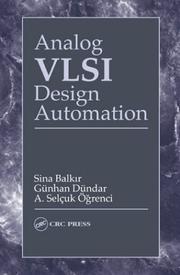
ISBN: 0849310903 Year: 2003 Publisher: Boca Raton : CRC,
Abstract | Keywords | Export | Availability | Bookmark
 Loading...
Loading...Choose an application
- Reference Manager
- EndNote
- RefWorks (Direct export to RefWorks)
Samenvatting:The explosive growth and development of the integrated circuit marketover the last few years have been mostly limited to the digital VLSIdomain. The difficulty of automating the design process in the analogdomain, the fact that a general analog design methodology remainedundefined, and the poor performance of earlier tools have left the analogworld with few, if any, options for automated VLSI design.Analog VLSI Design Automation may well mark the dawn of a new era. Itdescribes a fully integrated, top-down approach to analog VLSI designautomation and presents a methodology for each level of the designhierarchy. The authors define an analog VLSI design automation flow inwhich every tool has its predefined objectives and interfaces. Theypresent working examples for each tool, and demonstrate the validity oftheir approach by running their design automation system from the top tothe bottom levels in three different case studies.Technologies like systems-on-a-chip (SOCs) have created a pressing needfor automated design tools capable of handling analog circuit blocks. Theideas presented in this book are fully adaptable to various designclasses. Using these ideas, you will be able to develop new methodologiesand algorithms that will significantly reduce design costs and time tomarket for many practical systems.

ISBN: 0131455370 Year: 2004 Publisher: Upper Saddle River : Prentice Hall,
Abstract | Keywords | Export | Availability | Bookmark
 Loading...
Loading...Choose an application
- Reference Manager
- EndNote
- RefWorks (Direct export to RefWorks)
This book outlines a new, essential methodology for developing SoC hardware and software using configurable, extensible processor technology as a unifying theme. In addition to laying out a dramatically new SOC design methodology, the book introduces the concepts of processor configuration, extension, hardware/software co-generation and multiple processor partitioning and communication. It uses real-world examples extensively, both in the form of case studies about architecture decisions and in very short examples that communicate the flavor and the power of these methods. No other book discusses how to use multiple processors on a single chip to speed the chip design process and achieve faster performance. All other books that cover SoC design assume the traditional 1980's-style approach to system design that employs one central processor or, at most, one processor and a co-processor such as a digital signal processor (DSP) on a chip. Other books assume that if there are parts of the design that can't be run fast enough on the main system processor, then the designer must hand-code those parts of the design in hardware-description language (HDL) such as Verilog or VHDL. That was state-of-the-art thinking for chip design in the early 1990s, but as chip complexity increased and configurable, embedded processor cores were introduced and established, SoCs with multiple processors are proving to be an effective alternative.
Book
ISBN: 0879421134 0471052116 Year: 1978 Publisher: New York : IEEE Press : sole worldwide distributor exclusive of the IEEE, Wiley,
Abstract | Keywords | Export | Availability | Bookmark
 Loading...
Loading...Choose an application
- Reference Manager
- EndNote
- RefWorks (Direct export to RefWorks)
Geïntegreerde schakelingen. --- Linear integrated circuits. --- Telecommunicatie.
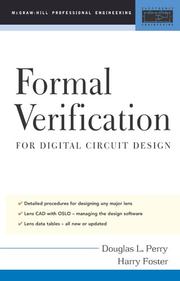
ISBN: 007144372X Year: 2005 Publisher: New York : McGraw-Hill,
Abstract | Keywords | Export | Availability | Bookmark
 Loading...
Loading...Choose an application
- Reference Manager
- EndNote
- RefWorks (Direct export to RefWorks)
PREFACE Chapter 1: Introduction to Verification Chapter 2: Verification Process Chapter 3: Current Verification Techniques Chapter 4: Introduction to Formal Techniques Chapter 5: Formal Basics and Definitions Chapter 6: Property Specification Chapter 7: The Formal Test Plan Process Chapter 8: Techniques for Proving Properties Chapter 9: Final System Simulation APPENDIX A: IEEE 1850 PSL PROPERTY SPECIFICATION LANGUAGE APPENDIX B: IEEE 1800 SYSTEM VERILOG ASSERTIONS BIBLIOGRAPHY INDEX
Digitale elektronica. --- Geïntegreerde schakelingen. --- Logische schakelingen.
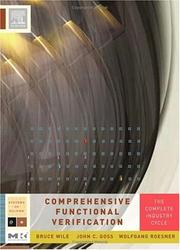
ISBN: 0127518037 Year: 2005 Publisher: Amsterdam : Elsevier,
Abstract | Keywords | Export | Availability | Bookmark
 Loading...
Loading...Choose an application
- Reference Manager
- EndNote
- RefWorks (Direct export to RefWorks)
One of the biggest challenges in chip and system design is determining whether the hardware works correctly. That is the job of functional verification engineers and they are the audience for this comprehensive text from three top industry professionals. As designs increase in complexity, so has the value of verification engineers within the hardware design team. In fact, the need for skilled verification engineers has grown dramatically-functional verification now consumes between 40 and 70 per cent of a project's labor, and about half its cost. Currently there are very few books on verification for engineers, and none that cover the subject as comprehensively as this text. A key strength of this book is that it describes the entire verification cycle and details each stage. The organization of the book follows the cycle, demonstrating how functional verification engages all aspects of the overall design effort and how individual cycle stages relate to the larger design process. Throughout the text, the authors leverage their 35 plus years experience in functional verification, providing examples and case studies, and focusing on the skills, methods, and tools needed to complete each verification task. Additionally, the major vendors (Mentor Graphics, Cadence Design Systems, Verisity, and Synopsys) have implemented key examples from the text and made these available on line, so that the reader can test out the methods described in the text. This book provides comprehensive overview of the complete verification cycle. It combines industry experience with a strong emphasis on functional verification fundamentals and includes industry examples and real-world case studies.
Computer engineering. --- Geïntegreerde schakelingen. --- Integrated circuits --- Logische schakelingen. --- Verification.
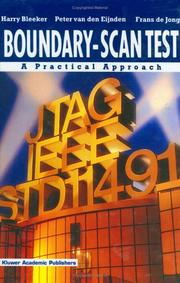
ISBN: 0792392965 1461363713 1461531322 9780792392965 Year: 1993 Publisher: Dordrecht Boston london Kluwer Academic Publishers
Abstract | Keywords | Export | Availability | Bookmark
 Loading...
Loading...Choose an application
- Reference Manager
- EndNote
- RefWorks (Direct export to RefWorks)
BST (Printed circuit board testing method) --- Boundary scan methods --- Boundary scan testing --- Printed circuits --- Scrutation périphérique (Microélectronique) --- Circuits imprimés --- Design and construction --- Conception et construction --- Beproevingsmethoden --- Geïntegreerde schakelingen --- vlsi geïntegreerde schakelingen --- boundary scan test --- Design and construction. --- Testing --- Beproevingsmethoden. --- Geïntegreerde schakelingen. --- vlsi geïntegreerde schakelingen. --- Vlsi geïntegreerde schakelingen. --- Printed circuits - Design and construction
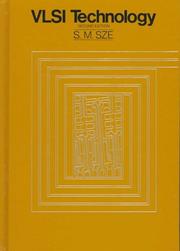
ISBN: 0070627355 0071003479 9780070627352 9780071003476 Year: 1988 Publisher: New York (N.Y.) MacGraw-Hill
Abstract | Keywords | Export | Availability | Bookmark
 Loading...
Loading...Choose an application
- Reference Manager
- EndNote
- RefWorks (Direct export to RefWorks)
Integrated circuits --- Very large scale integration --- Very large scale integration of circuits --- VLSI circuits --- Very large scale integration. --- vlsi geïntegreerde schakelingen --- vlsi geïntegreerde schakelingen. --- Vlsi geïntegreerde schakelingen. --- Integrated circuits - Very large scale integration
Book
ISBN: 0471814547 Year: 1984 Publisher: New York John Wiley & Sons
Abstract | Keywords | Export | Availability | Bookmark
 Loading...
Loading...Choose an application
- Reference Manager
- EndNote
- RefWorks (Direct export to RefWorks)
621.382 --- Geïntegreerde circuits --- IC --- mos --- transistor --- operationele versterker --- analoge techniek (analoge elektronica) --- opamp --- Geïntegreerde schakelingen --- Geïntegreerde schakelingen. --- Bipolar transistors --- Linear integrated circuits --- Metal-oxide semiconductors
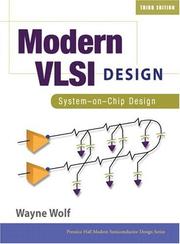
ISBN: 0130619701 Year: 2002 Publisher: Upper Saddle River (N.J.) : Prentice-Hall,
Abstract | Keywords | Export | Availability | Bookmark
 Loading...
Loading...Choose an application
- Reference Manager
- EndNote
- RefWorks (Direct export to RefWorks)
Preface. 1. Digital Systems and VLSI. 2. Transistors and Layout. 3. Logic Gates. Int. 4. Combinational Logic Networks. 5. Sequential Machines. 6. Subsystem Design. 7. Floorplanning. Introduction. 8. Architecture Design. 9. Chip Design. 10. CAD Systems and Algorithms. Appendix A- A Chip Designer's Lexicon. Appendix B- Chip Design Projects. Class Project Ideas. Project Proposal and Specification. Design Plan. Design Checkpoints and Documentation. Appendix C- Kitchen Timer Model. Hardware Modeling in C.
| Listing 1 - 10 of 35 | << page >> |
Sort by
|

 Search
Search Feedback
Feedback About UniCat
About UniCat  Help
Help News
News